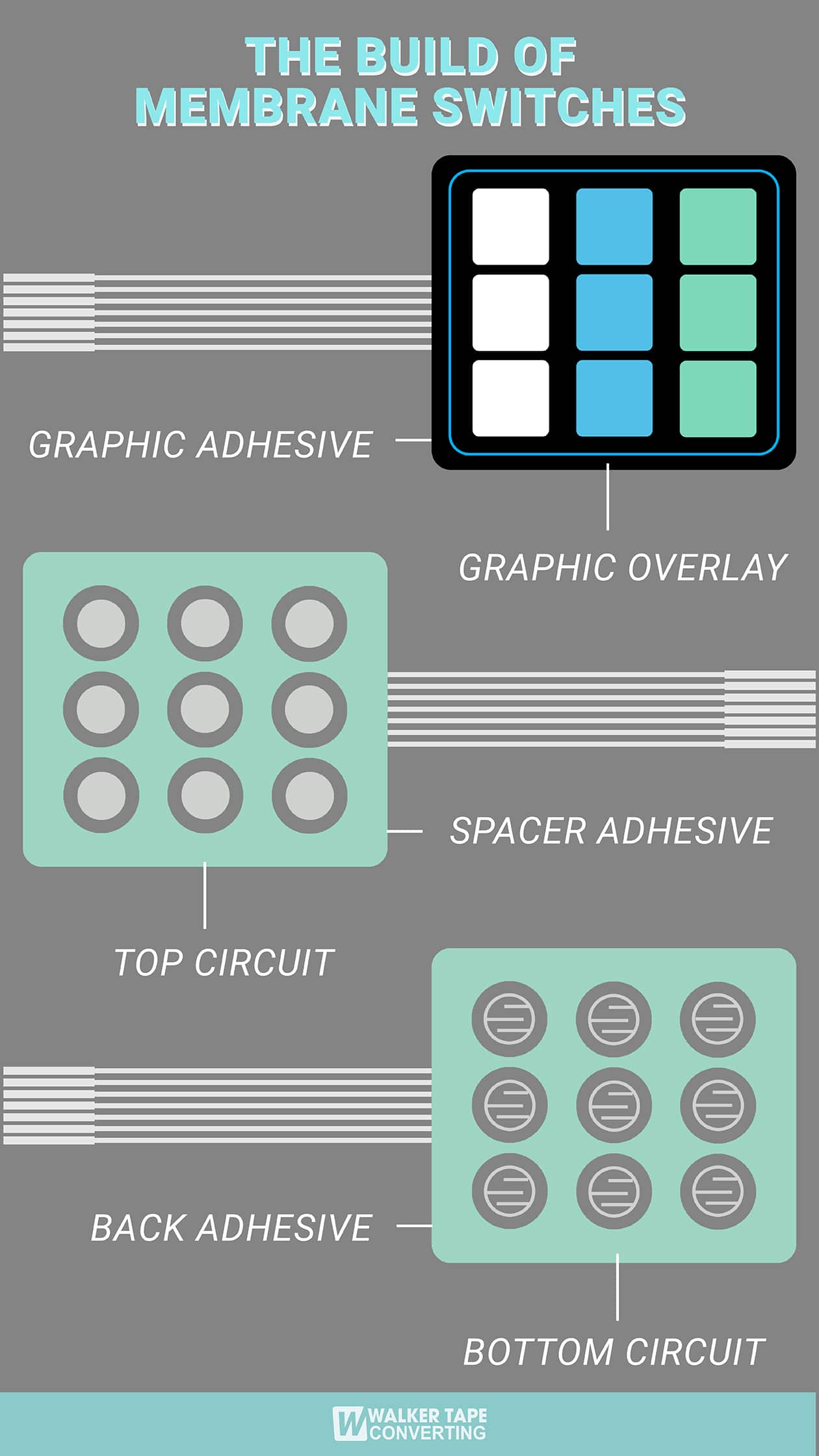Everything About Membrane Switch: A Comprehensive Overview for Beginners
Membrane switches are essential parts in modern electronics, offering an unique user interface for customer interaction - membrane switch. Their split building and construction, including overlays and conductive traces, offers functionality and resilience. Unlike typical mechanical buttons, membrane buttons present a streamlined design and customizable options. Recognizing their key attributes and advantages can transform item design. However, the details of their application and layout factors to consider call for more exploration
What Is a Membrane layer Change?
A membrane switch is a type of electrical button that is composed of a flexible membrane layered over a printed circuit card. This design allows for a streamlined and compact interface, typically used in numerous electronic devices. Membrane buttons are commonly located in consumer appliances, medical equipment, and commercial machinery because of their durability and resistance to environmental factors.The construction usually includes numerous layers, such as graphic overlays and adhesive backing, which supply tactile comments and safeguard the circuitry beneath. The procedure of a membrane layer switch is started when stress is used to the surface, completing an electric circuit.These switches are valued for their versatility, making it possible for custom-made layouts and published graphics that satisfy specific user interfaces. Their low-profile nature lowers room demands, making them perfect for applications where standard buttons might not fit. On the whole, membrane buttons supply a useful and visual remedy for contemporary digital gadgets.
Key Elements of Membrane Switches Over
Membrane switches make up several crucial parts that add to their functionality and performance. The leading layer, called the overlay, gives the interface and is often published with icons or graphics. Underneath the overlay lies a spacer layer, which separates the conductive components and stops unintended activation. The next important component is the visuals layer, which enhances aesthetic appeals and assures the toughness of the design.Conductive traces, normally made from materials like silver or carbon, are published on the circuit layer. When stress is put on the overlay, these traces come into call, completing the circuit. In addition, a support layer supplies structural assistance and can be made from materials such as polyester or polycarbonate. With each other, these elements develop a trustworthy, easy to use interface appropriate for different applications, from house home appliances to industrial equipment. Comprehending these elements is necessary for anybody thinking about membrane button modern technology.
Exactly How Membrane Layer Switches Over Work
Recognizing how membrane changes feature is vital for valuing their widespread use in various tools. A membrane layer switch runs through a collection of layers, including a graphic overlay, spacer, and a circuit layer. When stress is applied to the overlay, it compresses the spacer layer, permitting the circuit layer to make contact and complete an electrical circuit. This action sends out a signal to the device, triggering an action, such as activating a light or activating a function.Membrane switches can be developed with different attributes, including responsive responses, backlighting, and customized graphics, improving customer interaction. Their building enables a covered style, protecting the internal components from dust, moisture, and impurities. This longevity makes them appropriate for diverse applications, from consumer electronic devices to industrial equipment. In general, the simplicity and performance of membrane switches add to their appeal in contemporary technology.
Advantages of Membrane Layer Switches Mechanical Buttons
While mechanical switches have long been a staple in numerous devices, membrane switches over deal distinctive benefits that make them progressively appealing. One considerable advantage is their slim profile, enabling even more small styles and better adaptability in item advancement. Additionally, membrane layer changes feature an uniform surface area, which improves aesthetic appeal and simplifies cleaning, making them ideal for settings where hygiene is critical.Another benefit is their resistance to dirt and wetness. Unlike mechanical switches, which can be endangered by environmental elements, membrane buttons offer a closed user interface that safeguards against impurities - membrane switch. Membrane layer switches normally have a longer lifespan due to less moving components, resulting in enhanced longevity and reliability.Cost-effectiveness is likewise a notable benefit, as membrane buttons can be produced in bulk with reduced manufacturing prices. These elements incorporate to position membrane buttons as a practical option to typical mechanical options in different applications
Usual Applications of Membrane Changes
Membrane layer switches are extensively utilized in numerous industries, especially in customer electronics and industrial control board. In customer gadgets, they offer a sleek, easy to use user interface, while in commercial setups, they enhance toughness and capability. Understanding these applications highlights the flexibility and practicality of membrane layer buttons in modern-day innovation.
Customer Electronic Devices Devices
As consumer electronics continue to evolve, membrane buttons have ended up being a popular option for a range of gadgets as a result of their convenience and smooth style. These buttons are frequently located in smart devices, tablets, and remote controls, where space is limited and looks issue. Their reduced account and personalized layouts enable producers to produce easy to use interfaces that enhance the overall user experience. Furthermore, membrane layer switches are usually made use of in devices such as microwaves and coffee makers, offering user-friendly control alternatives while standing up to wetness and dirt. The sturdiness and dependability of membrane layer changes make them suitable for day-to-day customer products, making certain longevity and consistent efficiency. On the whole, their combination in consumer electronic devices shows a blend of performance and modern layout.
Industrial Control Panels
The applications of membrane layer switches expand past consumer electronic devices, discovering significant use in commercial control panels. These buttons are preferred for their toughness and resistance to severe settings, making them excellent for producing and procedure control setups. They give a reliable user interface for operators to manage machinery, display processes, and readjust settings. Membrane switches can be customized to fit specific functional demands, integrating attributes like backlighting and responsive responses, boosting individual experience. Their low-profile design permits combination right into various equipment, while their capability to withstand spills, dust, and severe temperature levels warranties longevity. Generally, membrane layer switches contribute to risk-free and reliable operation in industrial applications, Home Page showing their versatility and efficiency in requiring settings.
Factors To Consider for Designing Membrane Layer Switches Over
When making membrane buttons, choosing the appropriate products is important to assure toughness and capability. look at this now Additionally, understanding layer configuration strategies can significantly impact the switch's performance and individual experience. These considerations play an essential role in creating efficient and reliable membrane switch styles.
Product Option Relevance
Product option plays an essential role in the design and functionality of membrane buttons. The picked products straight impact the switch's sturdiness, tactile reaction, and overall visual. Trick factors to consider include the substrate, which should offer structural integrity while enabling adaptability, and the graphic overlay, which requires to be immune to use and ecological aspects. Conductive products ought to guarantee trustworthy electric efficiency, while adhesives have to supply solid bonding without jeopardizing the switch's procedure. In addition, compatibility with making processes and end-user environments is essential; materials have to hold up against varying temperatures, moisture degrees, and chemical exposure. Inevitably, proper material choice not just enhances the membrane layer switch's efficiency yet also adds to its longevity and customer fulfillment, making it a critical aspect of the layout process.

Layer Arrangement Strategies

Frequently Asked Concerns
How Long Do Membrane Layer Changes Typically Last?
Membrane buttons generally have a life-span of 1 to 5 million cycles, depending upon use and environmental conditions. Variables such as design top quality and operating frequency considerably influence their sturdiness and total performance durability.

Can Membrane Switches Be Custom-made for Particular Designs?
Membrane layer buttons can undoubtedly be tailored to suit certain styles, enabling varied shapes, colors, and functionalities. This versatility makes it possible for suppliers to customize these buttons to fulfill one-of-a-kind visual and functional requirements efficiently.
What Products Are Utilized in Membrane Switch Over Building?
Membrane switches are typically built using materials such as polyester, polycarbonate, and glue layers. These materials supply flexibility, longevity, and resistance to ecological factors, making certain the switches function properly in numerous applications and conditions.
Are Membrane Changes Water-proof or Resistant to Dampness?
Membrane layer switches can be developed to be moisture-resistant, making use of specialized materials and finishings. Their water resistant abilities depend on building high quality and certain applications, making it necessary to analyze needs for excellent efficiency in numerous settings.
Just How Are Membrane Layer Changes Repaired if Damaged?
Repairing damaged membrane layer switches over commonly entails replacing the affected layer or circuit. Specialists might likewise apply conductive adhesive or make use of specialized repair work sets, guaranteeing performance is restored without full substitute of the entire switch assembly. Unlike typical mechanical buttons, membrane switches provide a smooth design and customizable alternatives. A membrane switch is a type of electrical button that is composed of a flexible membrane layer layered over a published circuit board. The procedure of a membrane layer switch is launched when stress is applied to the surface area, finishing an electrical circuit.These switches are valued for their versatility, making it possible for custom-made designs and published graphics that cater to specific individual interfaces. While mechanical switches have actually long been a staple in many devices, membrane changes offer distinctive advantages that make them progressively appealing. Membrane buttons usually have a longer lifespan due to less moving parts, resulting in improved resilience and reliability.Cost-effectiveness is additionally a significant advantage, as membrane buttons can be produced in mass with lower manufacturing prices.
Comments on “Latest trends in membrane switch development”